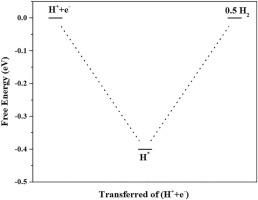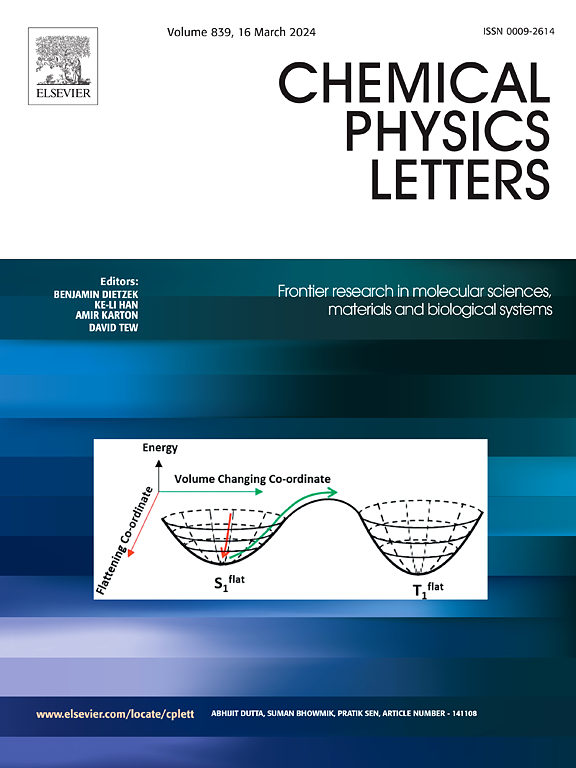Exploring transition metal-based electrocatalysts for carbon dioxide reduction: Towards enhanced product
IF 3.1
3区 化学
Q3 CHEMISTRY, PHYSICAL
引用次数: 0
Abstract
The development of advanced electrocatalysts has been considered crucial to capture chemically inert CO2 and for converting it into valuable products like fuel. It also plays a significant role in addressing the emission of greenhouse gasses and the energy crises in a sustainable manner. However, achieving control over product selectivity at low overpotentials is one the major challenges. This study employed density functional theory to investigate the electrocatalytic potential of different single transition metals (Ni, Co, and Fe) in the electrochemical reduction reaction of CO2 (hereafter ECO2RR). The efficacy of ECO2RR was evaluated based on the reaction intermediates (COOH, CHO and CO) when incorporated into BN-biphenyl monolayer (BNML) systems. Interestingly, incorporating Fe into BNML was found to be the most efficient option for ECO2RR, resulting in the production of CH4 with a remarkably low limiting potential (−0.31 V). In the hydrogen evolution reaction (HER), CO2 showed a higher affinity for the activation site on Fe-BNML compared to H2, indicating differences in adsorption energy (−0.92 vs. -0.40 eV). Additionally, Fe-BNML effectively suppressed HER during the ECO2RR process, with a HER limiting potential of −0.40 V. The findings can pave the way for developing low-potential electrocatalysts with improved selectivity and activity for CO2 reduction.

过渡金属基二氧化碳还原电催化剂的探索:迈向强化产物
先进电催化剂的发展被认为对捕获化学惰性二氧化碳并将其转化为有价值的产品(如燃料)至关重要。它在以可持续的方式解决温室气体排放和能源危机方面也发挥着重要作用。然而,在低过电位下实现对产物选择性的控制是主要的挑战之一。本研究采用密度泛函理论研究了不同单一过渡金属(Ni, Co, Fe)在CO2电化学还原反应(以下简称ECO2RR)中的电催化电位。根据加入bn -联苯单层(BNML)体系时的反应中间体(COOH、CHO和CO)来评价ECO2RR的效果。有趣的是,将Fe掺入到BNML中被发现是ECO2RR最有效的选择,导致CH4的产生具有非常低的极限电位(- 0.31 V)。在析氢反应(HER)中,CO2对Fe-BNML活化位点的亲和力高于H2,表明吸附能差异(- 0.92 vs -0.40 eV)。此外,Fe-BNML在ECO2RR过程中有效抑制HER, HER极限电位为- 0.40 V。这一发现为开发具有更高选择性和活性的低电位电催化剂铺平了道路。
本文章由计算机程序翻译,如有差异,请以英文原文为准。
求助全文
约1分钟内获得全文
求助全文
来源期刊

Chemical Physics Letters
化学-物理:原子、分子和化学物理
CiteScore
5.70
自引率
3.60%
发文量
798
审稿时长
33 days
期刊介绍:
Chemical Physics Letters has an open access mirror journal, Chemical Physics Letters: X, sharing the same aims and scope, editorial team, submission system and rigorous peer review.
Chemical Physics Letters publishes brief reports on molecules, interfaces, condensed phases, nanomaterials and nanostructures, polymers, biomolecular systems, and energy conversion and storage.
Criteria for publication are quality, urgency and impact. Further, experimental results reported in the journal have direct relevance for theory, and theoretical developments or non-routine computations relate directly to experiment. Manuscripts must satisfy these criteria and should not be minor extensions of previous work.
 求助内容:
求助内容: 应助结果提醒方式:
应助结果提醒方式:


